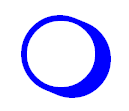|
41.Euclides
South-Eastern part of Oceanus Procellarum, at the eastern edge of the map
we see the Riphaeus mountains, in between the mountain massif Riphaeus
Zeta, and the crater Lansberg D we find a big Dome. And also numerous rows
of hills and solitary hill. Through a middle size telescope we
can see the rille Rima Hergonius I.
EUCLIDES
-
Eucildes (Εὐκλείδης)
(Born
about 300 BC). Greek mathematician, worked in Alexandria, Egypt. Author of
a work on geometry, "The Elements", in 13 parts. Organizer of school of
mathematics in Alexandrie.
 Crater.
(12Km /7Mi Ø ) (Dept: 1,000m /3,000ft) (7.4° S,
29.5° W) Strongly pronounced, bright coloured crater. Circular formation,
bowl shape and with bright ejecta situated to the west of Montes Riphaeus.
Steep slopes supporting a small mountain to the east, high walls, rounded
floor. Crater.
(12Km /7Mi Ø ) (Dept: 1,000m /3,000ft) (7.4° S,
29.5° W) Strongly pronounced, bright coloured crater. Circular formation,
bowl shape and with bright ejecta situated to the west of Montes Riphaeus.
Steep slopes supporting a small mountain to the east, high walls, rounded
floor.
HERIGONIUS
-
Pierre Hérigone. (Died in 1644) French
Mathematician, author of the 6 part "Cursus Mathematicus" also containing
"Spherical Astronomy" and a theory about the movement of the planets.
 Crater.
(15Km /9Mi
Ø ) (Dept: 2,100m /6,400ft) (13.3° S,
33.9° W) Isolated circular formation overlapping
Dorsa Ewing to the East Crater.
(15Km /9Mi
Ø ) (Dept: 2,100m /6,400ft) (13.3° S,
33.9° W) Isolated circular formation overlapping
Dorsa Ewing to the East
and supporting a craterlet to the north, steep slopes, high walls, flat
floor.
OCEANUS PROCELLARUM -
Ocean of Storms.
Named by
Riccioli (1651).
Riccioli's Moon Map.
 Ocean.
(721x488Km / 448x303Mi) (Centre: about 0.0° N, 50.0° W) Procellarum is the
largest of the maria, stretching more than 2,500 km (1,600 mi) across its
north-south axis and covering roughly 4,000,000 km2 (1,500,000
mi2 ). Larger lunar sea. 2,102,000 km2. Very flat to
the center. 80 m altitude difference in a 400 km diameter circle.
Numerous ridges rilles, leftovers of walls. Ghost craters and lava flooded
craters, many small hills. The landscape of the area depicted on chart 41
is basically the same. Rays from Crater Copernicus and other ray craters.
The robotic lunar probes Luna 9, Luna 13, Surveyor 1 and Surveyor 3 landed
in Oceanus Procellarum. The manned Apollo 12 mission also landed in
Oceanus Procellarum, with astronauts Pete Conrad and Alan Bean on board.
Their landing site, within 300m of Surveyor 3, has become known as Mare
Cognitum. North of Euclides F (5.2 km
ø
) (height: 1090m), and in surroundings of Herigonius are ridges which
should be counted amongst the most articulated systems on the Moon. Ocean.
(721x488Km / 448x303Mi) (Centre: about 0.0° N, 50.0° W) Procellarum is the
largest of the maria, stretching more than 2,500 km (1,600 mi) across its
north-south axis and covering roughly 4,000,000 km2 (1,500,000
mi2 ). Larger lunar sea. 2,102,000 km2. Very flat to
the center. 80 m altitude difference in a 400 km diameter circle.
Numerous ridges rilles, leftovers of walls. Ghost craters and lava flooded
craters, many small hills. The landscape of the area depicted on chart 41
is basically the same. Rays from Crater Copernicus and other ray craters.
The robotic lunar probes Luna 9, Luna 13, Surveyor 1 and Surveyor 3 landed
in Oceanus Procellarum. The manned Apollo 12 mission also landed in
Oceanus Procellarum, with astronauts Pete Conrad and Alan Bean on board.
Their landing site, within 300m of Surveyor 3, has become known as Mare
Cognitum. North of Euclides F (5.2 km
ø
) (height: 1090m), and in surroundings of Herigonius are ridges which
should be counted amongst the most articulated systems on the Moon.
RIPHEUS MONTES
-
Riphae Mountains. Greek Mythological mountains. (Compare map
42) The mountains
were according to Greek tradition the birthplace of the North-Wind.
Riphae Zeta is called "Ural" on older Moon charts.
 Mountains.
(155 x 38,5Km / 91 x 24Mi )
(7.7° S, 28.1° W) North - South oriented
mountain chain. Formed of isolated mountains
and parallel linkages. North part sometimes called Montes Ural. Flat
region contained in mountains to the north in communication with Mare
Cognitum. Mountains.
(155 x 38,5Km / 91 x 24Mi )
(7.7° S, 28.1° W) North - South oriented
mountain chain. Formed of isolated mountains
and parallel linkages. North part sometimes called Montes Ural. Flat
region contained in mountains to the north in communication with Mare
Cognitum.
WICHMANN
- Moritz
L. G. Wichmann. (1821 - 1859) German astronomer. Determined, and
discovered the inclination of the lunar equator, and proved as first the
physical libration of the Moon.
 Crater. (10Km / 6Mi
Ø ) (Dept: 1,000m /3,000ft) (7.5°
S, 38.1° W) Isolated circular formation with a bowl shape, situated to the
south
of a chain of hills in form of a stone lance. Few steep slopes supporting
a north-south oriented mountainous chain to the north. Few high walls.
Rounded floor. Crater. (10Km / 6Mi
Ø ) (Dept: 1,000m /3,000ft) (7.5°
S, 38.1° W) Isolated circular formation with a bowl shape, situated to the
south
of a chain of hills in form of a stone lance. Few steep slopes supporting
a north-south oriented mountainous chain to the north. Few high walls.
Rounded floor.
|
|
 |
